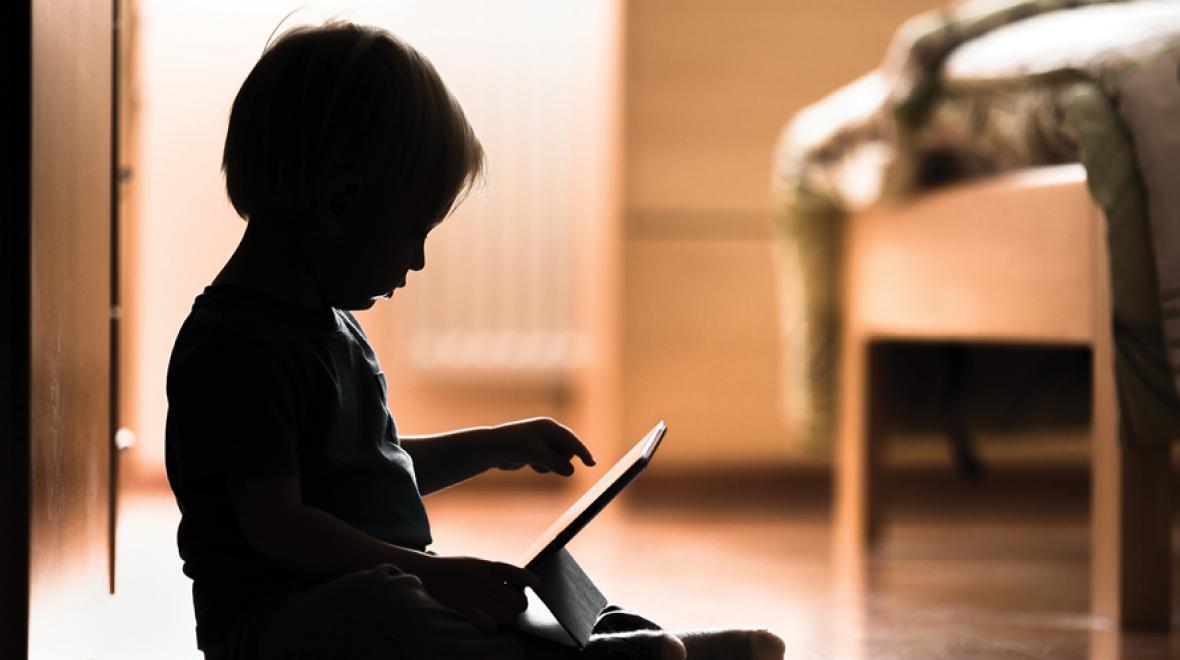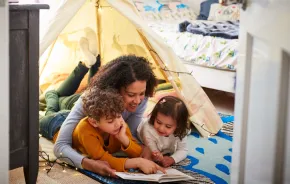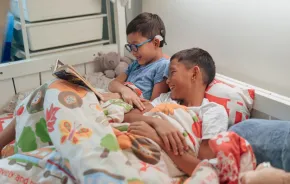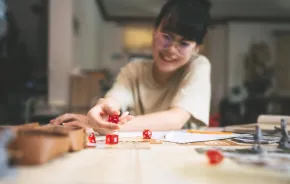
When it comes to our kids and the internet, we are probably worrying about the wrong things. Sure, the headlines about online predators, violent images and porn pop-ups can be terrifying, but in focusing on these evils, we may actually miss the bigger picture: The real danger is the impact of too much screen-time consumption on the healthy cognitive, social and emotional development of our children.
As a mother, educator and consultant, I hear about these challenges frequently from other parents, and I’m often asked: “Well, how much is ‘too much’ screen time?” I find this a difficult question to answer, because children respond differently to the same things; and the quality, frequency and length of screen time logged all can have an impact on the viewer. Even experts dodge this question about kids older than 6 because there are so many variables that go into understanding the impact of “too much.”
Although an American Academy of Pediatrics (AAP) report recommends no more than one hour of “high-quality programming” for children ages 2–5 (during which parents should “co-view”), they offer no time limit for children older than the age of 6, instead suggesting parents implement consistent limits. The AAP also says nothing about screen use in school or for schoolwork, a growing concern for many families that struggle to set limits on screen use at home. In April 2019, the World Health Organization issued new screen-time recommendations, suggesting zero time for children younger than 2 and one hour for kids ages 2–4, along with additional recommendations of increased exercise and sleep.
So, how do we know there are cognitive, social and emotional impacts on our children as a result of screen-time consumption if even the experts waffle about how to define what is “too much”?
Though there is no existing body of longitudinal research that conclusively correlates the negative repercussions of excessive screen time, I hear consistently from parents, teachers, occupational and physical therapists, counselors, early childhood educators and doctors that significant shifts in screen media consumption over the past 10 years have negatively impacted our children. Yes, there is conflicting research about the effects of screen time; yes, content and quality matter; and yes, you can find articles that suggest violent video games have no correlation to behavioral problems. However, I firmly believe that this public health issue, second to climate change, is the greatest challenge to the well-being of our children, and, like climate change, if we wait to see what the research concludes, it will be too late to do much about it.
If you feel, as many parents do, that you want to form new family habits around screen-time usage that will positively impact your children’s long-term health, consider these three suggestions.
Monitor time spent on screens.
It is easy to feel befuddled by the “how much is too much” question. In general, however, we know that kids are spending a lot more time in front of screens than ever before.
- Research from Common Sense Media’s 2017 census report on media use by children found that 98 percent of kids ages newborn to 8 years have access to internet-based devices at home. On average, kids are spending more than two hours per day in front of screens. (Also, it is worth noting that these are screen-time hours logged outside of school time. Screens in schools present a different challenge entirely.)
- How children use screens has also changed. According to Common Sense Media, in 2017, 35 percent of screen time was spent on mobile devices versus 4 percent in 2011. As many parents know, child screen usage often happens on the move (e.g., in the car, waiting in line, running errands). The idea of not watching a show in the car or while sidelined at your older sibling’s soccer game has become a foreign concept for most American children.
- There is a clear disconnect here between what the AAP says is best for children and what children are actually doing. If most 7-year-olds in America are spending 730 hours per year viewing a screen, when the recommended amount is “only” 365 hours per year (at most), that’s a lot of extra time spent not doing other activities that support healthy development. Douglas Gentile, Ph.D., of Iowa State University’s Media Research Lab uses the term “displacement” to describe this disconnect. When our kids spend 15 or more hours per week in front of a screen, what other skills are not being developed? What interests are not being nurtured?
Action item for parents: Parents, we can practice what we preach. It’s pretty humbling when our kids call us out on our own screen (over)use, but they are often right. Sure, being an adult means you have certain rights (not to mention responsibilities), but our kids cannot tell the difference between responding to a Slack message for work, texting a friend’s parent about carpooling and scrolling through Instagram. One easy action that parents can take is to “live your life out loud.” This means narrating (out loud!) what you are doing: “I’m texting Dad to see what time soccer is over”; “I’m looking up a recipe for dinner”; “I needed a break, so I am playing Candy Crush.” This models for our children how we personally use technology, and it also helps kids see that life requires coordination, planning and organizing — great executive function skills we all need!
Counteract the loss of real-life connections.
Imagine what would happen if your kids’ screen-time use were reduced by even one hour per day. How would they spend that additional time? We know that the rising obesity rate in children is a growing health crisis. Is excessive screen-time entertainment displacing your child’s outside play or sports? How would your child be impacted in school if they spent 365 additional hours per year reading?
Not all screen time is bad. We can all appreciate the amazing ways technology can connect us to others, support our work and entertain us when we seek stimulation. We do not yet have research on the long-term impacts of 700 hours of screen time per year per 5-year-old. But we do have decades of excellent research about what 5-year-olds or 8-year-olds (or even tweens and teens) need to develop strong neural pathways and build healthy relationships. And we know that most of that development happens through real-life interactions and experiences.
- Today, we have more “face time” than ever before with our children, but parental engagement is at an all-time low. Tech writer and consultant Linda Stone describes this notion of “continuous partial attention,” an adaptive behavior during which our attention is continually divided between tasks. Even if children don’t know the phrase for this phenomenon, they know what it looks and feels like: buried in our device as we push our child on the swing, or distracted by our social media feed as our child tries to get our attention. “Continuous partial attention” is the attempt to appear present and to be physically present, but to be emotionally disengaged and distracted at the same time. I often quote my husband, who once observed: “Texting is like giving someone who isn’t even in the room permission to interrupt you.”
- Research conducted by Dr. Jenny Radesky at the University of Michigan shows that the more distracted we are by our devices, the harder our kids will try to get our attention. And, of course, the more demanding they get, the more frustrated we feel about being interrupted. No one wins.
Action items for parents: Parents feel overwhelmed by the mental demands of modern life. But the reality is, we must prioritize real connection with our kids. This is not about guilting ourselves into better behavior. Guilt, like fear, isn’t a great motivator for creating lasting changes. We can find ways to be intentional about where and when we use tech around our kids. We can set boundaries for our home life and work life that protect one sphere from the other. We can share with our kids the challenges of “disconnecting to connect” — after all, they learn about healthy choices by watching us.
Prioritize sleep.
If we want to make only one change, but net the greatest positive impact, then I suggest prioritizing sleep for the whole family. Raising children is exhausting, and a sleep-deprived parent is not a patient parent. The good news is that, as kids get older, they start to sleep better (or at least they sleep more). However, for those smartphone-wielding tweens and teens, as screen-time usage climbs, the first thing that gets displaced is sleep.
When it comes to sleep, here are some key facts for parents to consider:
- A recent JAMA study found that only 1 in 20 American children gets the recommended amount of sleep.
- The AAP endorses a recommendation by the American Academy of Sleep Medicine that grade-schoolers need from 9 to 12 hours of sleep per night.
- The Center for Cyber Safety and Education conducted a children’s internet usage study of kids in fourth–eighth grades and found that 49 percent are online after 11 p.m. on school nights.
- There is a wealth of research that supports the argument that sleep is critical for healthy brain development, especially for growing children. Dr. Dan Siegel, a clinical professor of psychiatry at UCLA, has said that in terms of the physical impact on our bodies, not getting enough sleep is the equivalent of ingesting poison.
- Of course, it is easy to wonder why sleep has dropped off, and we can return to Gentile’s “displacement” concept to explain at least part of it. Teens in particular, when faced with the choice to sleep or spend more time on social media or texting with friends, do not have the fully formed executive function skills in place to make the healthier decision to prioritize sleep over socializing.
Action items for parents: Charge all devices outside of bedrooms. Use real alarm clocks, not phone-based ones. Set and stick to bedtimes for kids of all ages — the earlier you can form this habit, the easier it will be to enforce in the teen years.
In this day and age, it is easy to feel helpless and hopeless. But being paralyzed by our fears does not motivate us to change our behaviors. There are concrete things you can do as a parent to protect your child’s cognitive, social and emotional well-being, and it is not too late to start.











